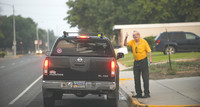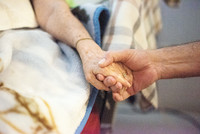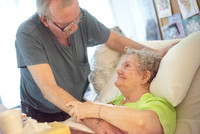Cloudy, 26° F
Even though Hank Ramak is no longer able to drive, that doesn’t stop the 72- year-old from finding a way to see the lady he loves. Two days a week, Ramak sets out from his home in Byron to …
This item is available in full to subscribers.
The Powell Tribune has expanded its online content. To continue reading, you will need to either log in to your subscriber account, or purchase a subscription.
If you are a current print subscriber, you can set up a free web account by clicking here.
If you already have a web account, but need to reset it, you can do so by clicking here.
If you would like to purchase a subscription click here.
Please log in to continue |
|



Even though Hank Ramak is no longer able to drive, that doesn’t stop the 72- year-old from finding a way to see the lady he loves. Two days a week, Ramak sets out from his home in Byron to catch a ride to Powell.
Ramak used to make the 32-mile round-trip daily, when he was still able to drive himself. But all that changed on May 30 — the Vietnam veteran’s birthday — when his driver’s license came up for renewal.
“I have macular degeneration,” explained Ramak. “It has gotten worse. I couldn’t even see well enough to fill out the form for my driver’s license.”
So, he started looking for rides — including by hitchhiking.
“The fact that I couldn’t drive any more wasn’t about to stop me from seeing Joyce,” he said.
Joyce Jackson and Ramak have been a couple for more than three decades.
To be exact: “34 years, 1 month and 26 days,” Ramak said on a recent day. “The good, the bad, and everything in between.”
The past eight of those years, Jackson has been a resident of the Powell Valley Care Center and Ramak has faithfully traveled from Byron to Powell to visit her. She’ll turn 83 next month.
Ramak met Jackson in 1980, while he was managing the Downtowner Liquor and Lounge in Cody. “Joyce would come in after work every day,” he recalled. “She doesn’t drink, but she loves her Pepsi. We hit it off.”
Jackson had just lost her first husband to M.S.
“In one week, I lost my husband, my mother and my son. Then I met Hank,” Jackson recalled, smiling at Ramak from her care center bed. “He’s the most wonderful person there is.”
Married to someone else at the time, Ramak divorced in 1983. He and Jackson got together in 1984 and have been a couple ever since.
Nine years ago, Jackson suffered a stroke. For the first seven months, Ramak tried to take care of her in their Byron home, but Jackson’s health continued to decline. In 2010, Ramak made the difficult decision to transfer Jackson to the Powell Valley Care Center and began driving from Byron to visit her.
“I bought a new car,” said Ramak. “The old one had given up the ghost; I was driving back and forth every day.”
Ramak said he began experiencing difficulties with his vision several years ago and has been told he needs corneal transplant surgery. The Department of Veterans Affairs will pay for the surgery, but not for the transportation to Salt Lake City, where he needs to go for the procedure, he said.
Unable to drive, Ramak now relies on the kindness of strangers to travel between Byron and Powell.
“It usually takes 1 1/2 to 2 hours to get to Powell,” said Ramak. “Sometimes I have to walk 4-5 miles before getting a ride.”
Typically, it doesn’t take long to catch a ride back to Byron, said Ramak, but one recent afternoon he was having difficulty and started walking from the care center.
He made it to Pizza Hut when a woman pulled over and asked if he was OK, telling him that he’d been staggering in the 97-degree heat.
“I said I was hot,” recalled Ramak.
The woman called her boss to say she was going to be late getting back from lunch, then drove Ramak to his home in Byron.
More recently, Ramak said he’s been fortunate to catch rides with nurses as they drive through Byron on the way to morning shifts in Powell and Cody.
Jackson is thankful Ramak comes to visit her at Powell Valley Care Center, “but I worry about him when he hitchhikes,” she added.
The least he could do
With few if any other options available (see related story below), Ramak plans to continue catching rides from Byron to Powell to visit Jackson. It’s not the first time in his life he’s had to hitch a ride.
Ramak recounted one particularly memorable journey. It was 1968, the height of the Vietnam War and anti-war protests. Ramak had just arrived back in the U.S. after serving in Vietnam as a paratrooper in the 101st Army Airborne Division.
Landing at Fort Ord, California, after an 18-hour flight, Ramak had to hitchhike the remaining 300-plus miles south to his hometown of Artesia. Ramak recalled standing by the side of the road in his uniform, trying to catch a ride.
“Someone threw a beer bottle at me,” he said. “It was a different time then.”
Ramak had enlisted in the U.S. Army at the age of 18 and spent three years in the service — including 10 months in Vietnam — even though he wasn’t a U.S. citizen.
“I figured if the country was good enough to take me in, the least I could do was fight for it,” Ramak said.
Born in Holland in 1946, Ramak emigrated to America with his parents and five siblings as a young child.
Ramak’s parents had been planning to move to South Africa, but “the Mormon church came in and said we will pay your way to the U.S.,” he said. “The only stipulation was you had to study the Mormon religion for two years.”
The family sailed from England to New York City.
Six years old at the time, “I remember we had 11 days of storms coming over,” he said.
After arriving in New York, Ramak’s family traveled by steam locomotive to Salt Lake City. They lived there for seven years before moving to Southern California.
Ramak and all his siblings eventually became U.S. citizens.
Describing himself as “the last holdout,” Ramak became a citizen in 2004.
Few transportation options in the Big Horn Basin
Hank Ramak’s story highlights the unique transportation challenges faced by Big Horn Basin residents who don’t drive.
“There is a large number of unserved individuals in the Big Horn Basin, whether they be senior citizens or anyone else, who need non-emergency transport,” said Denise Anderson, Director of the North Big Horn Senior Center in Lovell. “It’s a huge issue.”
“There’s no bus line, no taxi. I don’t think there’s even an Uber you can call,” added Anderson.
Both Byron and Powell provide transportation to senior citizens through their Senior Centers, but their services are limited to prescribed areas and there is no connecting service between the two towns. The North Big Horn Senior Citizens Center provides transportation between the communities of Lovell, Byron, Deaver and Frannie. The Powell Senior Center operates a van, but its service area only extends 10 miles outside of the city limits.
Because Ramak is visually impaired, he is potentially eligible for transportation assistance from the Rural Transportation Voucher (RTV) program, administered by Wyoming Services for Independent Living (WSIL).
“The RTV program is designed to provide assistance to people in rural areas that have a disability that is a barrier to their driving,” explained Marcia Henthorn, WSIL RTV Program Manager.
Funded by the Wyoming Department of Transportation (WYDOT), the RTV program provides vouchers that qualifying individuals with disabilities can use to reimburse a volunteer driver’s mileage expenses.
“But we have a limited amount of money, and a long wait list for new enrollment,” Henthorn added.
The current wait time is approximately two years, she said.